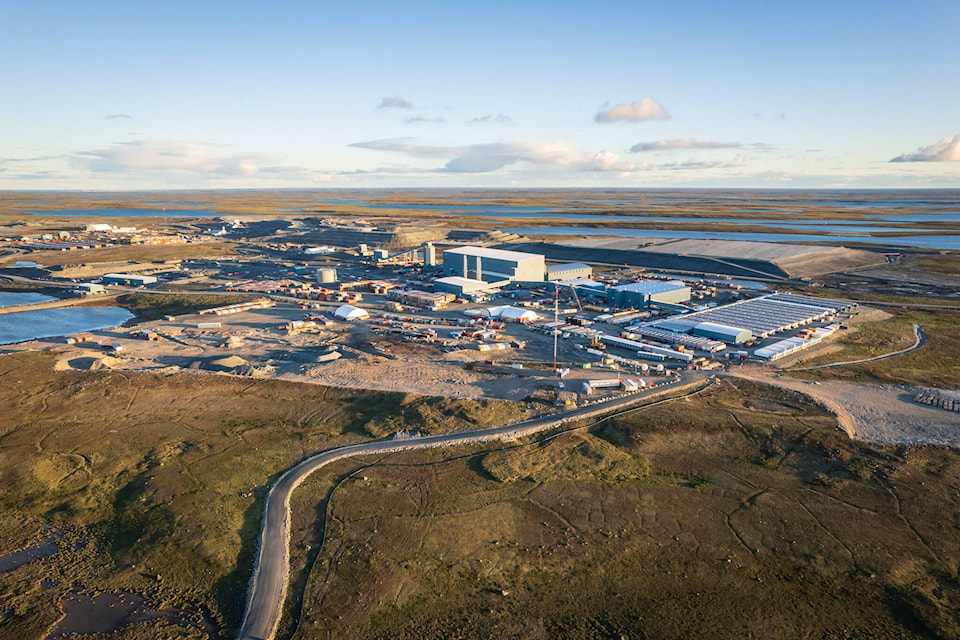Agnico Eagle has withdrawn its proposal to extend the Meliadine gold mine, citing problems with the Nunavut Impact Review Board’s report on the plans, as well as the need for the company to avoid any delays with its current operations.
“As we communicated publicly when the report was released, Agnico Eagle was surprised and disappointed by the NIRB’s recommendations,” wrote Jamie Quesnel, director of permitting and regulatory affairs with the company, in a letter to Northern Affairs Minister Dan Vandal Dec. 19.
In its Nov. 17 ruling, NIRB recommended that the Meliadine extension proposal not be allowed to proceed at this time, citing “considerable uncertainty of the potential for the proposal to have negative, lasting effects on caribou, and the uncertainty of cumulative effects.”
Agnico Eagle had sought to extend the mine’s life by 11 years through various expansions of their operation. At NIRB’s public hearings in Rankin Inlet earlier this past fall, critics of the proposal often targeted the windfarm, as the company was looking to construct up to 11 turbines to generate clean power for the mine.
“We had hoped that our suggestion at the end of the hearing that the windfarm be considered separate of the mine extension would have alleviated concerns regarding the windfarm’s proposed placement and impacts,” wrote Quesnel.
Other than issues Agnico Eagle had with NIRB’s report, the thrust of the company’s motivation to pull the extension proposal is to avoid any delays that could be caused for a number of components of the mine that have been approved by NIRB previously but are not yet added to the Type A water licence.
“While these components were only included in the Meliadine Extension Proposal for the sake of completeness and transparency, some of them will need to be approved as soon as 2024 by the Nunavut Water Board to support the current Meliadine mining plan,” explained Quesnel. “Please note, however, that we are not ruling out the submission of a new application regarding a Meliadine extension project, in due time and when conditions will be suitable.”
That decision would be different if NIRB had recommended the extension proposal, said Quesnel.
Attached to the letter is a nearly 50-page report detailing NIRB’s findings and Agnico’s responses.
“The 11-year extension of the mine life would maintain the current annual mining rate,” stated the company’s report. “It did not request an ‘intensification’ of mining, as the (NIRB) report suggests.”
The proposed changes at Meliadine would result in a minor footprint of less than one per cent and no material change to outputs, added another bullet point.
According to Agnico Eagle, monitoring of caribou show the mine “is not causing significant adverse effects to caribou.”
“The report often catalogues general concerns without considering a balanced approach and without considering the measures which the proponent, NIRB, the government departments and other parties such as the Kivalliq Inuit Association are taking to address them,” wrote Agnico Eagle.
Currently, the mine is expected to close in 2032, or thereabouts, if no extension is approved.
ᐊᒡᓃᑯᒃᑯᑦ ᐲᖅᑕᖓᑦ ᑐᒃᓯᕋᐅᑎᖓᑦ ᐅᐃᒍᒋᐊᕈᒪᑉᓗᒍ ᑕᓯᕐᔪᐊᕐᒥᑦ ᒎᓗᒧᑦ ᐅᔭᕋᒃᑕᕆᐊᖅ, ᐅᖃᖅᖢᑎᒃ ᐃᖢᐃᓗᑕᖃᕐᓂᖓᓄᑦ ᐊᕙᑎᓕᕆᔨᒃᑯᑦ ᐅᓂᑉᑳᖓᓂᑦ ᐸᕐᓇᐅᑎᖓᓐᓄᑦ, ᐊᒻᒪᓗ ᑲᒻᐸᓂᒃᑯᑦ ᓄᖅᖃᖓᑎᑦᑎᑦᑕᐃᓕᔭᕆᐊᖃᕐᓂᖏᓐᓂᒃ ᒫᓐᓇᐅᔪᖅ ᐊᐅᓛᖅᑎᑦᑎᓂᖓᓐᓂᑦ.
“ᑐᓴᖅᑎᑦᑎᓚᐅᖅᖢᑕ ᑭᑐᑐᐃᓐᓇᓂᒃ ᐅᓂᑉᑳᖅ ᓴᖅᕿᑕᐅᖕᒪᑦ, ᐊᒡᓃᑯᒃᑯᑦ ᓂᕆᐅᓚᐅᖏᑦᑐᑦ ᐊᒻᒪᓗ ᖁᕕᐊᓱᙱᖦᖢᑎᒃ ᐊᕙᑎᓕᕆᔨᒃᑯᑦ ᐱᖁᔨᓂᕆᔭᖏᓐᓄᑦ,” ᑎᑎᕋᖅᑐᖅ ᔩᒥ ᑯᐊᔅᓄᓪ, ᐊᖓᔪᖅᖄᖅ ᐱᔪᖕᓇᖅᑎᑦᑎᓂᕐᒧᑦ ᐊᒻᒪᓗ ᒪᓕᒐᓕᕆᓂᕐᓄᑦ ᑲᒻᐸᓂᒃᑯᓐᓂᑦ, ᑎᑎᖅᖃᒥᑦ ᐅᑭᐅᖅᑕᖅᑐᒧᑦ ᑲᒪᔨᓄᑦ ᒥᓂᔅᑕᐅᔪᒧᑦ ᑖᓐ ᕙᓐᑖᓪ-ᒧᑦ ᐋᒡᔪᓕᕐᕕᒃ 19-ᒥᑦ.
ᑲᑕᒑᕆᕝᕕᒃ 17-ᒥᑦ ᐃᓱᒪᓕᐊᖓᓐᓂᑦ, ᐊᕙᑎᓕᕆᔨᒃᑯᑦ ᑕᓯᕐᔪᐊᕐᒥᑦ ᐅᐃᒍᒋᐊᖅᓯᓂᕐᒧᑦ ᑐᒃᓯᕋᐅᑎᒥᒃ ᑲᔪᓯᖁᔨᓚᐅᖏᑦᑐᑦ ᒫᓐᓇᐅᔪᖅ, ᐅᖃᖅᖢᑎᒃ “ᐊᖏᔪᒥᒃ ᓇᓗᓇᕐᓂᖅᑕᖃᖅᑎᓪᓗᒍ ᑐᒃᓯᕋᐅᑕᐅᔪᖅ ᐱᑦᑕᐅᖏᑦᑐᓂᒃ, ᐊᑯᓂᐅᔪᒥᒃ ᖃᓄᐃᖓᓕᖅᑎᑦᑎᔪᖕᓇᕐᓂᖓᓄᑦ ᑐᒃᑐᓄᑦ, ᐊᒻᒪᓗ ᓇᓗᓇᕐᓂᖏᑦ ᑲᑎᑉᐸᓪᓕᐊᔪᓂᒃ ᐱᔪᓄᑦ.”
ᐊᒡᓃᑯᒃᑯᑦ ᐅᐃᒍᒋᐊᕈᒪᓚᐅᖅᑕᖓᑦ ᐅᔭᕋᒃᑕᕆᐊᑉ ᐊᐅᓛᕐᓂᖓ 11-ᑲᓐᓃᑦ ᐅᑭᐅᓄᑦ ᐊᔾᔨᒌᙱᑦᑐᓂᒃ ᐊᖏᒡᓕᒋᐊᖅᓯᓗᑎᒃ ᐊᐅᓛᖅᑎᑦᑎᓂᖏᓐᓄᑦ. ᐊᕙᑎᓕᕆᔨᒃᑯᑦ ᑭᑐᑐᐃᓐᓇᓂᒃ ᑲᑎᒪᑎᑦᑎᓂᖓᓐᓂᑦ ᑲᖏᖅᖠᓂᕐᒥᑦ ᐅᑭᐊᒃᓵᖑᓚᐅᖅᑐᒥᑦ, ᐃᑲᔪᖅᑐᐃᖏᓐᓂᖃᖅᑐᓂᑦ ᑐᒃᓯᕋᐅᑕᐅᔪᒥᑦ ᐅᖃᐅᓯᕆᔭᐅᒐᔪᓚᐅᖅᑐᑦ ᐊᓄᕆᒧᑦ ᑲᐃᕕᑎᑕᐅᔪᓄᑦ ᐃᓂᒋᔭᐅᓂᐊᖅᑐᖅ, ᑲᒻᐸᓂᒃᑯᑦ 11-ᓂᒃ ᓇᑉᐸᖅᓯᔪᒪᓚᐅᕐᒪᑕ ᓴᓗᒪᔪᒥᒃ ᐆᒻᒪᖅᖁᑎᓕᐅᕆᓂᐊᖅᑐᓂᒃ ᐅᔭᕋᒃᑕᕆᐊᕐᒧᑦ.
“ᓂᕆᐅᓚᐅᖅᑐᒍᑦ ᐱᔪᒪᔭᕗᑦ ᐃᓱᐊᓂᑦ ᑲᑎᒪᑎᑦᑎᓂᕐᒥᑦ ᐊᓄᕆᒧᑦ ᑲᐃᕕᑎᑕᐅᔪᓂᒃ ᐃᓂᒋᔭᐅᔪᖅ ᐃᓱᒪᒃᓴᖅᓯᐅᕈᑕᐅᓂᐊᕐᓗᓂ ᐊᑉᓯᒪᓗᒍ ᐅᔭᕋᒃᑕᕆᐊᕐᒥᑦ ᐅᐃᒍᒋᐊᖅᓯᓂᕐᒥᑦ ᐃᓱᒫᓘᑎᖃᓗᐊᖅᑎᑦᑎᓇᔭᓚᐅᖏᑦᑐᖅ ᐊᓄᕆᒧᑦ ᑲᐃᕕᑎᑕᐅᔪᓄᑦ ᐃᓂᖏᓐᓄᑦ ᑐᒃᓯᕋᐅᑕᐅᔪᒥᑦ ᐊᒻᒪᓗ ᐊᒃᑐᖅᓯᓂᐅᔪᓂᑦ,” ᑎᑎᕋᖅᑐᖅ ᑯᐃᔅᓂᐅᓪ.
ᐊᓯᖏᓐᓂᑦ ᐱᔾᔪᑕᐅᔪᓂᑦ ᐊᒡᓃᑯᒃᑯᑦ ᐊᕙᑎᓕᕆᔨᒃᑯᑦ ᐅᓂᑉᑳᖓᓄᑦ ᐱᔾᔪᑎᖃᖅᑐᓂᑦ, ᐱᒋᐊᕈᒪᓂᕆᔭᖓᑦ ᑲᒻᐸᓂᒃᑯᑦ ᐱᒋᐊᖅᑎᓐᓂᐊᕐᓗᒍ ᐅᐃᒍᒋᐊᖅᓯᓂᕐᒧᑦ ᑐᒃᓯᕋᐅᑎ ᓄᖅᖃᖓᑎᑦᑎᔪᒪᙱᖦᖢᑎᒃ ᐱᔾᔪᑕᐅᔪᖕᓇᖅᑐᓂᒃ ᖃᑉᓯᐊᕐᔪᐃᑦ ᐃᓚᒋᔭᐅᔪᓄᑦ ᐅᔭᕋᒃᑕᕆᐊᕐᒥᑦ ᓈᒻᒪᒋᔭᐅᕌᓂᓚᐅᖅᑐᑦ ᐊᕙᑎᓕᕆᔨᒃᑯᓐᓄᑦ ᑭᓯᐊᓂ ᐃᓚᔭᐅᓚᐅᖏᖦᖢᑎᒃ ᓱᓕ Type A ᐃᒪᕐᒧᑦ ᓚᐃᓴᓐᓯᒧᑦ.
“ᑖᑉᑯᐊ ᐃᓚᒋᔭᐅᔪᑦ ᐃᓚᐅᑎᑕᐅᑐᐃᓐᓇᓚᐅᖅᑎᓪᓗᒋᑦ ᑕᓯᕐᔪᐊᕐᒥᑦ ᐅᐃᒍᒋᐊᖅᓯᓂᕐᒧᑦ ᑐᒃᓯᕋᐅᑎᒥᑦ ᐱᔾᔪᑎᖃᖅᖢᑎᒃ ᐱᐊᓂᑦᑎᐊᖅᓯᒪᓂᕐᒧᑦ ᐊᒻᒪᓗ ᑕᑯᒃᓴᐅᔪᒃᑰᖓᓂᕐᒧᑦ, ᐃᓚᖏᑦ ᓈᒻᒪᒋᔭᐅᔭᕆᐊᖃᕐᓂᐊᖅᑐᑦ ᕿᓚᒥᐅᔪᒥᑦ 2024-ᒥᑦ ᓄᓇᕗᒻᒥ ᐃᒪᓕᕆᔨᒃᑯᓐᓄᑦ ᐃᑲᔪᕐᓂᐊᕐᓗᓂ ᒫᓐᓇᐅᔪᖅ ᑕᓯᕐᔪᐊᕐᒥᑦ ᐅᔭᕋᒃᑕᕐᓂᕐᒧᑦ ᐸᕐᓇᐅᑎᒥᑦ,” ᐅᖃᖅᑐᖅ ᑯᐊᔅᓂᐅᓪ. “ᖃᐅᔨᒪᓂᐊᖅᐳᓯ, ᑭᓯᐊᓂ, ᐲᙱᑕᕗᑦ ᓄᑖᒥᒃ ᑐᒃᓯᕋᐅᑎᒥᒃ ᑕᓯᕐᔪᐊᕐᒥᑦ ᐅᐃᒍᒋᐊᖅᓯᓂᖅ, ᐱᔪᒫᕐᓗᒍ ᓈᒻᒪᒃᓯᒃᐸᑦ ᐊᒻᒪᓗ ᖃᓄᐃᖓᓂᐅᔪᑦ ᓈᒻᒪᒃᓯᒃᐸᑕ.”
ᐃᓱᒪᓕᐊᖑᔪᖅ ᐊᔾᔨᒋᓇᔭᓚᐅᖏᑕᖓ ᐊᕙᑎᓕᕆᔨᒃᑯᑦ ᐱᖁᔨᓚᐅᖅᐸᑕ ᐅᐃᒍᒋᐊᖅᓯᓂᕐᒧᑦ ᑐᒃᓯᕋᐅᑎᒥᑦ, ᐅᖃᖅᑐᖅ ᑯᐃᔅᓂᐅᓪ.
ᑎᑎᖅᖃᒥᑦ ᐃᓚᐅᔪᖅ 50 ᒪᒃᐱᖅᑐᒐᐃᑦ ᖃᓂᑖᓃᑦᑐᑦ ᐅᓂᑉᑳᖅ ᐃᓗᐊᓃᑦᑐᑦ ᐊᕙᑎᓕᕆᔨᒃᑯᑦ ᖃᐅᔨᔭᖓᓐᓂᑦ ᐊᒻᒪᓗ ᐊᒡᓃᑯᒃᑯᑦ ᑭᐅᔭᖏᓐᓂᑦ.
“11 ᐅᑭᐅᓂᑦ ᐅᐃᒍᒋᐊᖅᑕᐅᓂᖓ ᐅᔭᕋᒃᑕᕆᐊᖅ ᐱᑕᖃᖅᑎᑦᑎᓇᔭᖅᑐᖅ ᒫᓐᓇᐅᔪᖅ ᐊᕐᕌᒍᑕᒫᒃᑯᑦ ᖃᓄᑎᒋ ᐅᔭᕋᒃᑕᕐᓂᐅᔪᒥᑦ,” ᐅᖃᖅᓯᒪᔪᖅ ᑲᒻᐸᓂᒃᑯᑦ ᐅᓂᑉᑳᖓᓂᑦ. “ᑐᒃᓯᕋᓚᐅᖏᑦᑐᖅ ‘ᐱᒋᐊᓪᓚᒃᑲᓐᓂᕐᓂᐊᖅᑐᓂᒃ’ ᐅᔭᕋᒃᑕᕐᓂᕐᒥᒃ, ᐊᕙᑎᓕᕆᔨᒃᑯᑦ ᐅᓂᑉᑳᖓᓂᑦ ᐅᖃᖅᓯᒪᓂᖓᑐᑦ.”
ᐊᓯᐊᙳᖅᑕᐅᔪᒪᔪᑦ ᐅᔭᕋᒃᑕᕆᐊᕐᒥᑦ ᒥᑭᔪᒥᑦ ᐃᓂᒋᔭᐅᔪᒨᓇᔭᖅᑐᑦ ᑐᖔᓃᑦᑐᒥᑦ 1 ᐳᓴᓐᑎᐅᑉ ᐊᒻᒪᓗ ᐊᑐᖅᑕᐅᔪᓂᒃ ᐊᓯᐊᙳᖅᑐᖃᕋᔭᙱᑦᑐᖅ ᐱᕙᓪᓕᐊᔭᐅᔪᓂᑦ, ᐅᖃᖅᓯᒪᒃᑲᓐᓂᖅᑐᖅ.
ᐅᖃᖅᑕᖓᓐᓂᑦ ᐊᒡᓃᑯᒃᑯᑦ, ᖃᐅᔨᓴᐃᓂᖅ ᑐᒃᑐᓂᒃ ᑕᑯᒃᓴᐅᑎᑦᑎᔪᖅ ᐅᔭᕋᒃᑕᕆᐊᖅ “ᐊᖏᔪᒥᒃ ᐅᔾᔨᕐᓇᖅᑐᓂᒃ ᖃᓄᐃᖓᓕᖅᑎᑦᑎᓂᖃᙱᑦᑐᖅ ᑐᒃᑐᓄᑦ.”
“ᐅᓂᑉᑳᖅ ᑲᑎᑦᑎᓂᖅᓴᐅᖃᑦᑕᖅᑐᖅ ᐃᓱᒫᓘᑕᐅᔪᓂᒃ ᐃᓱᒪᒃᓴᖅᓯᐅᕈᑎᒋᙱᖦᖢᒋᑦ ᐃᒡᓗᒌᖕᓂᒃᑯᑦ ᐊᑐᕐᓂᐊᕐᓗᑎᒃ ᐊᒻᒪᓗ ᐃᓱᒪᒋᙱᖦᖢᒋᑦ ᐱᓕᕆᐊᖑᔪᑦ ᐱᓕᕆᐊᓕᐅᑉ, ᐊᕙᑎᓕᕆᔨᒃᑯᑦ, ᒐᕙᒪᒃᑯᑦ ᐊᕕᒃᑐᖅᓯᒪᔪᖏᑦ ᐊᓯᖏᓪᓗ ᐃᓚᒋᔭᐅᔪᑦ ᓲᕐᓗ ᑭᕙᓪᓕᕐᒥᑦ ᐃᓄᐃᑦ ᑲᑐᔾᔨᖃᑎᒌᒃᑯᑦ ᐱᔭᖏᓐᓂᑦ ᐱᓕᕆᐊᕆᓂᐊᕐᓗᒋᑦ,” ᑎᑎᕋᖅᑐᑦ ᐊᒡᓃᑯᒃᑯᑦ.
ᒫᓐᓇᐅᔪᖅ, ᐅᔭᕋᒃᑕᕆᐊᖅ ᓂᕆᐅᒋᔭᐅᔪᖅ ᐅᒃᑯᐊᕐᓂᐊᕐᓂᖓᓄᑦ 2032-ᒥᑦ, ᐅᕝᕙᓘᓐᓃᑦ ᖃᓂᑖᓂᑦ, ᐅᐃᒍᒋᐊᖅᓯᓂᖅ ᐊᖏᖅᑕᐅᖏᑉᐸᑦ.
